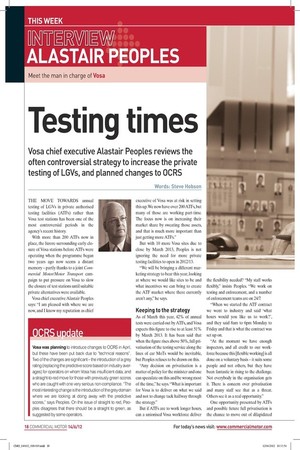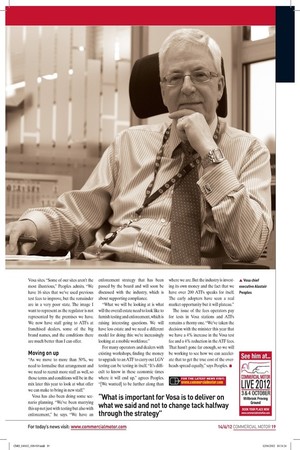Testing times
Page 12

Page 13

If you've noticed an error in this article please click here to report it so we can fix it.
Vosa chief executive Alastair Peoples reviews the often controversial strategy to increase the private testing of LGVs, and planned changes to OCRS
THE MOVE TOWARDS annual testing of LGVs in private authorised testing facilities (ATFs) rather than Vosa test stations has been one of the most controversial periods in the agency’s recent history.
With more than 200 ATFs now in place, the furore surrounding early closure of Vosa stations before ATFs were operating when the programme began two years ago now seems a distant memory – partly thanks to a joint Commercial Motor/Motor Transport campaign to put pressure on Vosa to slow the closure of test stations until suitable private alternatives were available.
Vosa chief executive Alastair Peoples says: “I am pleased with where we are now, and I know my reputation as chief executive of Vosa was at risk in setting this up. We now have over 200 ATFs, but many of those are working part-time. The focus now is on increasing their market share by sweating those assets, and that is much more important than just getting more ATFs.” But with 10 more Vosa sites due to close by March 2013, Peoples is not ignoring the need for more private testing facilities to open in 2012/13.
“We will be bringing a different marketing strategy to bear this year, looking at where we would like sites to be and what incentives we can bring to create the ATF market where there currently aren’t any,” he says.
Keeping to the strategy
As of March this year, 42% of annual tests were carried out by ATFs, and Vosa expects this figure to rise to at least 51% by March 2013. It has been said that when the figure rises above 50%, full privatisation of the testing service along the lines of car MoTs would be inevitable, but Peoples refuses to be drawn on this.
“Any decision on privatisation is a matter of policy for the minister and one can speculate on this and be wrong most of the time,” he says. “What is important for Vosa is to deliver on what we said and not to change tack halfway through the strategy.” But if ATFs are to work longer hours, can a unionised Vosa workforce deliver the flexibility needed? “My staff works flexibly,” insists Peoples. “We work on testing and enforcement, and a number of enforcement teams are on 24/7.
“When we started the ATF contract we went to industry and said ‘what hours would you like us to work?’ , and they said 8am to 6pm Monday to Friday and that is what the contract was set up on.
“At the moment we have enough inspectors, and all credit to our workforce because this [flexible working] is all done on a voluntary basis – it suits some people and not others, but they have been fantastic in rising to the challenge. Not everybody in the organisation gets it. There is concern over privatisation and many staff see that as a threat. Others see it as a real opportunity.” One opportunity presented by ATFs and possible future full privatisation is the chance to move out of dilapidated Vosa sites. “Some of our sites aren’t the most illustrious,” Peoples admits. “We have 16 sites that we’ve used previous test fees to improve, but the remainder are in a very poor state. The image I want to represent as the regulator is not represented by the premises we have. We now have staff going to ATFs at franchised dealers, some of the big brand names, and the conditions there are much better than I can offer.
Moving on up
“As we move to more than 50%, we need to formalise that arrangement and we need to recruit more staff as well, so those terms and conditions will be in the mix later this year to look at what offer we can make to bring in new staff.” Vosa has also been doing some scenario planning. “We’ve been marrying this up not just with testing but also with enforcement,” he says. “We have an enforcement strategy that has been passed by the board and will soon be discussed with the industry, which is about supporting compliance.
“What we will be looking at is what will the overall estate need to look like to furnish testing and enforcement, which is raising interesting questions. We will have less estate and we need a different model for doing this: we’re increasingly looking at a mobile workforce.” For many operators and dealers with existing workshops, finding the money to upgrade to an ATF to carry out LGV testing can be testing in itself. “It’s difficult to know in these economic times where it will end up,” agrees Peoples. “[We wanted] to be further along than where we are. But the industry is investing its own money and the fact that we have over 200 ATFs speaks for itself. The early adopters have seen a real market opportunity but it will plateau.” The issue of the fees operators pay for tests in Vosa stations and ATFs remains a thorny one. “We’ve taken the decision with the minister this year that we have a 4% increase in the Vosa test fee and a 4% reduction in the ATF fees. That hasn’t gone far enough, so we will be working to see how we can accelerate that to get the true cost of the overheads spread equally,” says Peoples. n










































